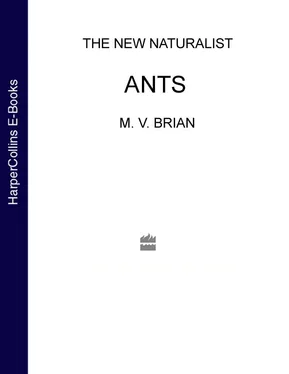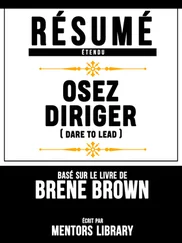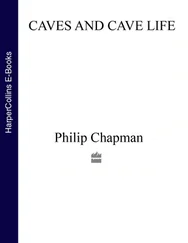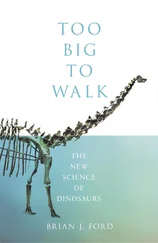A typical situation has just been described; in fact there are many variations. Thus in primitive societies the queens may forage to begin with. Again, not all queens can fly and some can but do not (they prefer to stay in the parental nest). Often new colonies are founded as buds of existing ones, complete with all types and stages from the start. Quite a lot of species are socially parasitic, either temporarily during colony initiation or permanently, and in some of these workers no longer appear and males are wingless. Although in all ants the workers have no wings, and in most they lack sperm sacs, in many species they do in fact lay eggs. These are of course unfertilized but they may develop into males or, rarely, females but they can also serve as a food store.
By the Eocene period (70 million years ago) a great many varieties of ants had evolved, many of them much the same in size, shape and structure as those that exist today; presumably they were social, too, but perhaps to a lesser degree. Even from the Upper Cretaceous period (100 million years ago) a primitive worker ( Sphecomyrma ) is known. It shows characteristics in common with certain families of solitary wasps. The first few steps towards social life are obscure. A likely speculation suggests that it all started with a wasp-like creature that collected soil animals, put them in cells, laid eggs on them and then went off. On hatching the larvae burrowed into the prey and ate it; if too many eggs were laid the smaller, weaker sisters were eaten, too. If the female remained with the brood and protected it from enemies an incipient society would exist. Social evolution might have progressed from this stage if the parent continued to collect prey and lay eggs after the first ones had hatched. This would provide the larvae with additional food which could have been taken directly while the parent herself was eating. An important stage in evolution occurred, it is suggested, when the female lived long enough to control the behaviour of the first young adults, prevent their escaping, finding males and founding new groups. Later perhaps wingless progeny which were able to work immediately, by-passing resting stages, dispersal flights, copulation and other phases of the earlier life cycle would be produced. Caste size differences would follow slowly. Direct feeding on prey gave way in most ants (some of the time but not entirely) to egg-eating, sucking up regurgitated digests and, ultimately, to taking milk made in one-time digestive glands. If several equal-aged females associated to start a society, it is likely that the work would be shared in some way: those with bigger and better-developed ovaries would lay eggs whilst others foraged (perhaps with an interchange of functions occasionally). Today the most primitive of surviving ants are found in Australia. On one of these, Amblyopone australis , the first cell to be made is left open and the queens forage for prey in the soil, even before the eggs hatch. These eggs are formed into a mass and may be eaten and, as it were, re-laid fresh at any time. The first larvae are fed on solid insect food; they eventually mature into workers which are as big as the queens and very similar structurally (except for the absence of wings). They can get out of their cocoons without help. These workers forage for prey and feed the brood. In spite of this help the queens go on working and more may join the group from time to time. Myrmecia is another primitive type; it constructs an open cell and forages regularly for nectar, only collecting insects when its eggs hatch. If deprived of prey it can make some growth so presumably it has a body source of food, perhaps its thoracic wing muscles. On a similar level is the European genus Manica of the myrmicine ants which excavates a small nest, leaves the entrance open and goes out to collect prey for its larvae. The workers the queen produces are considerably smaller than herself.
Finally, a stage of evolution is reached which has been called claustral; in this the queen seals herself in a hole and produces the first brood from her own body reserves entirely. Such a limited food supply would favour the evolution through natural selection of small workers which can be produced both more quickly and more economically. However, a big caste divergence necessitates the establishment of effective methods of intercommunication, co-operation and, above all, control. Thus the general theme of ant evolution is from small groups of structurally similar, very versatile females to large groups of structurally dissimilar, highly specialized, interdependent females.
THIS is no more than a brief account of the main structural features of females (queens and workers) and their larvae. Males and pupae are only treated superficially. Myrmica rubra will be used as a type; it is a fairly unspecialized species whose structure was meticulously studied by Charles Janet at the end of the nineteenth century. Some of his diagrams have been adapted and reproduced here.
Like all insects, ants have a hard external covering. This cuticle is many-layered and chemically complex; apart from protecting the body mechanically and providing a strong basis for muscle attachment it also screens out dangerous solar rays and reduces the amount of water vapour that escapes. Water loss can be substantial even in quite humid conditions and this last function is very important to terrestrial animals. Flexibility is achieved by joining rigid segments by a supple connecting membrane folded and tucked inside for protection. Although ants are by no means as hairy as bees they do have a great many simple and usually rather short setae scattered over most parts of the body. Spines also occur in some groups.
As in all insects the ant’s body is divided into three parts – head, thorax and abdomen. The unusual feature in ants (and most other members of this insect order, the Hymenoptera) is the evolution of a petiole towards the front of the abdomen. This is formed by reducing one or two segments to narrow tubes and articulating them. This separates a middle body (called the mesosoma) composed of the thorax and one abdominal segment from a hind body (the gaster) made up of the last seven segments (not all of these are visible). The number of petiole segments is two in the sub-family Myrmicinae ( fig. 1) and one in other ants; formicine ants usually have a scale on their petiole ( fig. 7). Most of the hinging motion occurs between the mesosoma and the first petiole segment and lies in a vertical plane; the gaster can be brought round under the mesosoma until its tip reaches up to near the jaws. In this way an enemy or prey can be located with the antennae, grasped with the jaws and immediately stung or sprayed with toxin. Damage caused by the bite probably helps the venom to penetrate. In a similar way eggs in the genital aperture can be brought round to the mouth and picked up in the jaws. The ventral side of the gaster can also be bent under the thorax and can be used to stop small objects, principally brood, from slipping backwards as they are being manipulated by the forefeet and mouthparts.
The head is very flexibly articulated on to the thorax and the actual junction protected above by a stiff collar which projects forward from the thorax. The head can be moved downwards and rotated sideways but cannot be lifted very much. However it is arranged in the long axis of the body so that the jaws protrude, an obvious advantage in defensive situations.
The most important sense organs are the antennae ( figs. 6, 7). They are hinged so that they can be both extended well in front of the jaws or, in dangerous situations, folded back so that they lie close to the head itself. This hinge occurs at the junction of a long, thin, basal segment (called the scape) and a highly-subdivided club (called the funiculus). These organs undoubtedly help the ant to understand the size and shape of objects in its environment: they can be moved through a wide arc independently or the tips can be brought together on to small objects much less than a millimetre in diameter. A wide variety of chemicals can also be detected and recognized by the antennae and they may also respond to sounds and vibrations in the substratum.
Читать дальше












